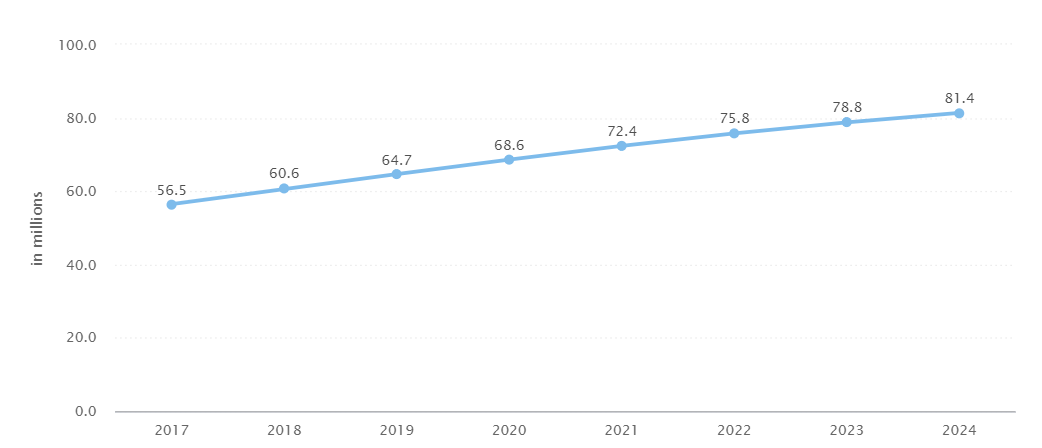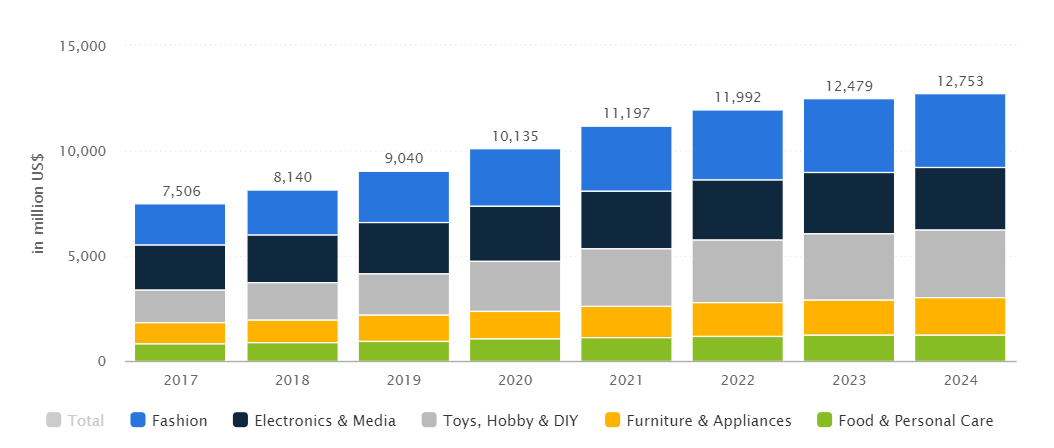Conquering Mexican ecommerce
Mexico is uniquely positioned as the second largest ecommerce market in Latin America after Brazil and is projected as one of the fastest growing worldwide, which means it is a great opportunity for online businesses seeking to position themselves in this market.
In 2019, the Mexico economy grew 0.8%, reaching a GDP of US $1.2 trillion. Online buyer penetration is around 45%, meaning that of its 130 million inhabitants, close to 68 million are frequent online shoppers. These shoppers have an average age of 28 years, a young audience that is well versed in digital adoption. This group boasts a 40% penetration rate for mobile phones, leaving 52 million computers circulating in the market that serve as the as the main means of online shopping and purchases.
Web Users ( Millions)

Source: Statista
80% of the Mexican population live in cities, which is great news for the digital market – a market that in 2020 reached a volume of 80 million transactions and a total volume of US $10 billion. This was a growth of 20% from the previous year, and yet this only represents 2% of total retail sales, which means there is significant growth potential.
US & Mexico Ecommerce Sales

Source: Statista
On average, Mexican consumers spend an average of US $350 on online purchases each quarter, with the most purchases happening during the national shopping event called "El Buen Fin,” which is similar to the US event Black Friday in November. Additionally, Mexico’s "Hot Sale" hosted by AMVO -- the Mexican Association of Online Sales -- occurs in May each year and sees very high online sales. Like the US, Mother’s Day, Father’s Day, Christmas, and Cyber Monday are top sales events as well.
If you are interested in taking advantage of one of these shopping events, or just to break into the growing Mexican market, there are some important things to consider. Below is a list that will give you a well-rounded view of how the market functions and what you should look out for:
Overview:
- Product descriptions, details, terms and conditions must be in Spanish and all prices should be in Mexican pesos (MXN)
- Dimension details should be in grams or kilograms and weight measurements such as length, height, etc. in centimeters or meters.
- A local SEO strategy must be configured with keywords that will target the specific market you are looking to hit. It is recommended that you consult the query volume by words in Google Ads.
Regulatory Aspects:
Packaging and delivery regulations are detailed in the Norma Oficial Mexicana (NOM) which are a series of official, compulsory standards and regulations for operations in Mexico. The most important of these standards are:
- General labeling of consumer goods (NOM-050-SCFI-1994)
- Labeling of food and non-alcoholic beverages (NOM-051-SCFI-1994)
- Labeling of alcoholic beverages (NOM-142-SSA1-1995)
- Labeling of textiles, clothing, and accessories (NOM-004-SCFI-1994)
- Labeling of leather and artificial materials with leather-like appearance, footwear, leather goods, and products made of these materials (NOM-020-SCFI-1997)
- Labeling of electrical and electronic products, as well as household appliances (NOM-024-SCFI-1998)
- Labeling of paints, varnishes, and similar goods (NOM-003-SSA1-1993)
Source: Amazon
Concerning business tax, the tax authority is https://www.sat.gob.mx/home. The most important taxes to consider are:
- Value-added tax (IVA): Customs authorities collect a value-added tax (VAT) upon entry of goods into Mexico
- Special tax (IEPS): Applies to imports of certain products (e.g., alcoholic beverages) and can range from 25% to 160%
- Customs processing fee (DTA)
- Prescreening fee (prevalidación): Fee charged by Mexico customs (or sometimes by private companies engaged by the customs department) in connection with validation of the information before submission to customs
Source: Amazon
Prohibited Products:
It is important to consult with a customs and logistics agent to go over the full list of prohibited products for distribution in Mexico to avoid any problems in your distribution plans. Generally speaking, the prohibited products are as follows:
- Furs
- Electronic cigarettes
- Alcoholic beverages
- Seeds
- Precious metals
- Plants
- Weapons
- Tobacco
- Chocolate
Top Selling Products:
Tourism services are among the most purchased in Mexico (e.g. flights, hotels, and transportation) followed closely by electronics, fashion, and home furnishings. Below is a rundown of the average order value (AOV) of each of these top-selling industries:
- For tourism services, the AOV is US $200
- For electronics, the average AOV is US $250 and 1.5 items per purchase.
- For fashion, the AOV is US $50 and 3 items per purchase
- For home furnishings, the AOV is US $340 and 2.5 items per purchase.
Source: https://www.bizlatinhub.com/
Website Benchmarks (Competitor Research)
To guarantee success on your website, it is important to study the most representative ecommerce site in the market currently. By researching their marketing and promotional strategies, you can better define your strategy. Among the largest ecommerce sites currently in Mexico are:
- Mercado Libre: 130 million monthly visitors
- Amazon: 60 million monthly visitors
- Walmart: 28 million monthly visitors
- Coppel: 23 million monthly visitors
- Liverpool: 22 million monthly visitors
- Sam’s Club: 7 million monthly visitors
- Best Buy: 5 million monthly visitors
- TicketMaster: 3 million monthly visitors
Ecommerce Platform Choice:
Choosing the right ecommerce platform will not only determine your ability to sell into Mexico but could be the determining factor in the success of your business. There are many options for both small business and enterprise organizations, so doing your research to find the right fit is very important. Here are some of the most popular platforms that we see selling well into the Mexico market:
- Shopify: One of the most popular tools worldwide, given the simplicity of its process. It is recommended for small businesses. It offers many features and its monthly cost ranges from US $29 to US $300.
- BigCommerce: a platform with a higher cost, but a very good alternative for businesses with higher volumes. Offers a complete store without complex obstacles, advanced security settings, and easy integration for payment methods.
- Magento: The most corporate solution, Magento requires development and programming resources to execute it. The basic version is free, but the business license can cost US $20,000. This solution is not recommended for small businesses.
- WooCommerce: The plug-in for Wordpress Ecommerce, which quickly allows a site to start selling online. The interesting thing about WooCommerce is that it includes a built-in shopping cart.
- Squarespace: A solution recognized for its ease of design and multiple templates that allow you to build sites that are pleasing to the eye. The monthly price starts from US $18 and allows recurring purchases and recovery of abandoned shopping carts.
Payment Gateway Selection:
Once your ecommerce platform has been chosen, your next step is to choose the company that will help you process the payments for your customer’s orders. A payment gateway is the purchasing enabler that allows users to make payments with credit, debit, and cash payment methods.
A payment gateway that knows the Mexico market is ideal if you are planning to sell into this country. A company like Paymentez will help you navigate the different preferred payment methods and provide you with local support for all your payment needs.
There are traditionally two main models of payment gateways:
- Aggregator Model: This is a model in which an ecommerce application service pulls together various merchants and provides them with several payment gateways to process their payments. This model is suited for some small businesses, as it does not require the merchant to have its own merchant account. The payments are processed and the aggregator assumes the bank commissions, but funds only paid out after a certain period of time. This is an easy model to implement, but the waiting period for the order payment may not be ideal.
- Gateway Model: The gateway model provides the merchant with its own merchant account to directly receive funds. In this model, the merchant assumes all bank commissions, but is ideal for guaranteeing continuous cash flow.
Chargebacks are an important variable to monitor with any payment platform you choose. A chargeback is the payment amount that is returned to a debit or credit card after a customer disputes a transaction. The chargeback process can be initiated by either the merchant or the cardholder’s issuing bank, and usually means that a merchant will be responsible for the fees from a card issuer.
It is best to do a monthly review of your percentage of chargebacks applied in relation to sales, with the objective of not exceeding 2% as a recommended measure. If you have a higher chargeback rate, you might be looking at higher fees as well as the potential to be considered a high risk merchant which puts you at risk for having your account terminated.
Choosing a Fraud Protection Solution
Online fraud is a serious and growing business. Once you have your website and payment gateway chosen, it is time to think about how you will protect yourself from card not present fraud. Your payment gateway may have solutions in place that will help, but if you want to ensure that you are fully protected, you should look into outsourcing your fraud protection.
A comprehensive fraud solution will not only help you avoid chargebacks before they happen by screening each order for potentially risky or fraudulent behaviors, but it will also go beyond to ensure that your regular fraud software does not turn away good customers by declining orders that are actually legitimate (called “false declines”). These orders are harder to track, but studies have shown that up to 60% of your declined order rate could be good orders that a fraud software has flagged and declined based on rules that are not always on target.
Some of the rules that machine learning and AI systems look at for fraudulent activity are:
- Maximum purchase amount per user in a period of time
- Maximum number of purchases per user in a period of time
- Country of issuance of credit card
- IP address and location of order
- Buyer's location (billing versus shipping addresses)
- Number of emails enabled
- Number of purchase attempts enabled
- Previous online shopping behavior
- Behavioral demographics (keystrokes, incorrect attempts, etc.)
ClearSale not only has the local knowledge to walk you through the risks that merchants face in particular markets, but they have the largest in-house team of fraud analysts. They never decline a risky order without a manual review by a highly trained specialist, so that you can stop chargebacks before they happen and never turn away a good order again.
These are some of the most important steps that you should look to take before considering opening your ecommerce site in Mexico. There are many benefits to selling into this growing market, and with the right guidance along the way, you should see great success. Bienvenido a Mexico y Buenas Ventas !!!
 Andres F Roldan
Andres F Roldan